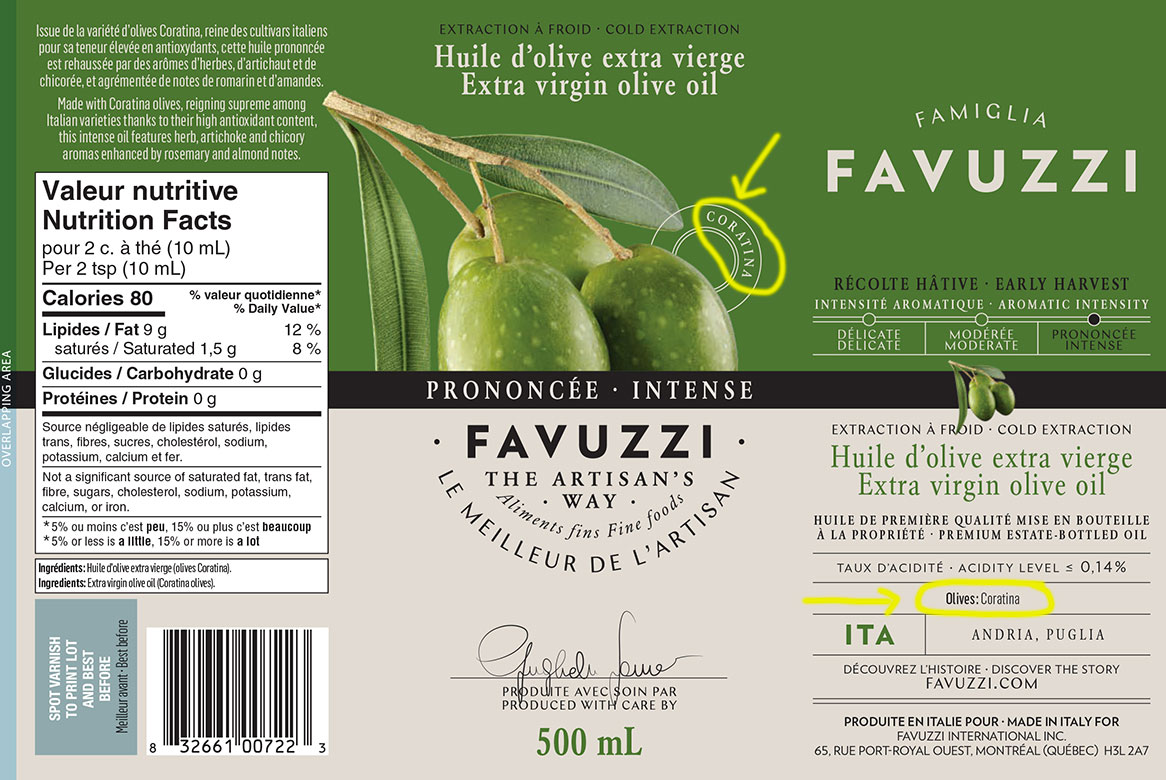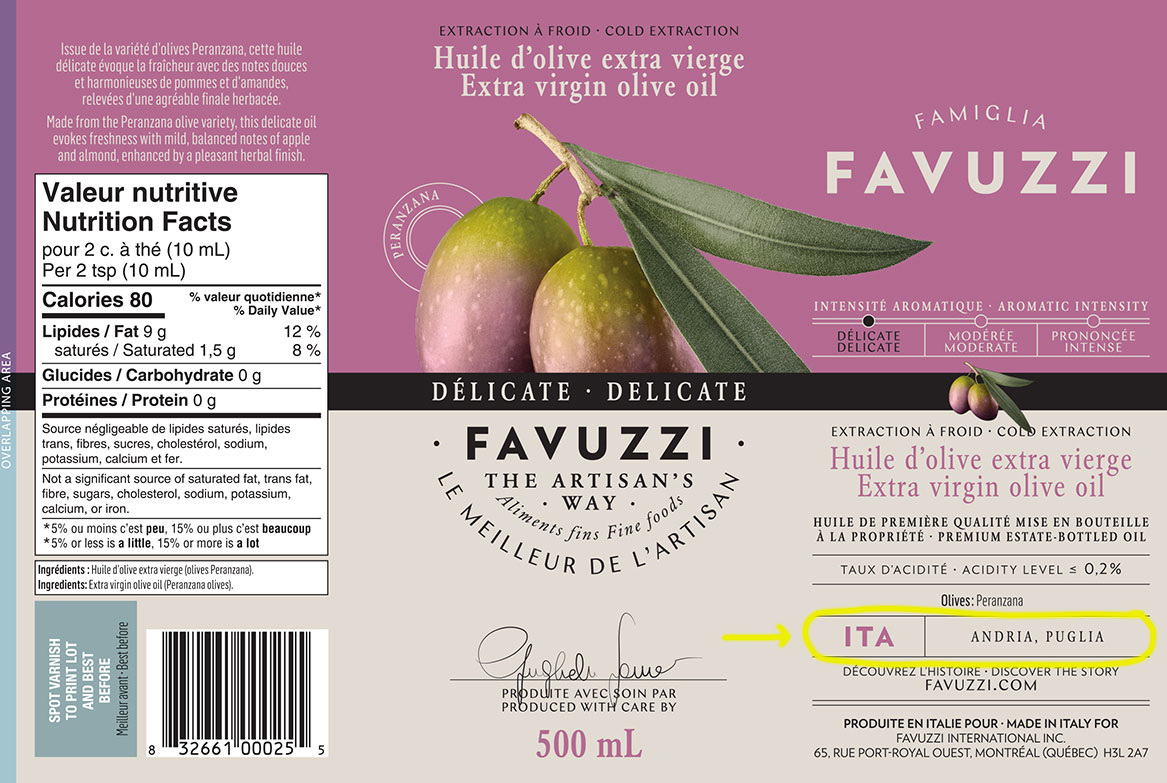June 16 2022
How to read the label on a bottle of high quality EVOO
When seeking a high-quality olive oil, there are a few things you should look for on the label.
First, make sure it includes the words "extra-virgin" olive oil. This means the oil is made from pure, cold-pressed olives. Then, look for a product that has a "best by" date that is 18 months or less from the time of bottling. It's also important to look for a bottle that is dark in colour, since light can damage the quality of the oil. A bottle of premium extra-virgin olive oil can cost anywhere from $15 to $30. The price depends on a number of factors, including the quality of the olives used, the production process, and the producer’s reputation. In general, higher-quality olive oils will cost more than lower-quality olive oils.
A noticeable difference with higher-quality extra-virgin olive oil is the quantity of additional information you can find on the label. Dedicated producers put so much care and effort in making their oils, they want to make sure they aren’t confused with mass-produced brands.
If you can’t taste the oil to verify its freshness or sample it before purchase, then you will appreciate the additional information provided on the label, and the closer you will be to buying a better tasting product.
Here are some additional details that are only found on premium olive oil labels:
- Olive varietals
- Specific geographical area of production
- Harvest date
- Acidity level
- Intensity profile
The olive varietals
The varietal is important because it provides a sense of the oil’s flavour profile. It also indicates that it’s not just a blend of any kind of olive. In Italy alone, there are hundreds of different varietals resulting in an extraordinary wide scope of aromatic profiles. Some common varietals include:
- Arbequina: this olive is native to Spain and has a slightly fruity flavour with hints of green apple.
- Koroneiki: this Greek varietal is known for its pungent, peppery flavour.
- Coratina: this olive grown in Puglia, Italy, is known for its strong and peppery aftertaste. When made into olive oil, Coratina olives produce an oil that is full-bodied and tasty, and pairs well with strong-flavoured foods. Our intense olive oil is made with 100% Coratina olives, and combines perfectly with grilled meats and fish.
- Manzanilla cacereña: this olive oil has a light and fruity flavour, with notes of green apple and almond. It is well-balanced and has a clean, fresh finish. Our moderate intensity olive oil is made with 100% Manzanilla cacereña olives and features a balanced taste of herb, artichoke, tomato and ripe fruit aromatic notes.
- Peranzana: this olive oil has a distinct taste that sets it apart from other olive oils. It is fruity and sweet, with a hint of bitterness. The taste is well-balanced, and the oil is smooth and velvety. Peranzana olive oil is perfect for drizzling over salads or using in dips. Our delicate intensity olive oil is exclusively made with Peranzana olives harvested and crushed in northern Puglia.

Specific geographical area of production
When it comes to olive oil, authenticity is everything. The origin of the olive must be carefully considered in order to ensure it is of the highest quality. Industrial production methods can produce large quantities of olive oil quickly and cheaply, but they often sacrifice quality in the process. Artisanal producers, on the other hand, take great care to produce a high-quality product. They may not produce as much olive oil as industrial producers, but their products are often more authentic and of better quality. When choosing an extra-virgin olive oil, it is important to consider the origin of the oil in order to ensure its authenticity and high quality. Make sure the origin of the olives and the production site are clearly indicated on the label. If they are not, chances are it is a blend of different olive oils from various producers to create a generic product with little character and identity. And, don’t confuse “organic” certification with quality. It’s not because an olive oil is organic that it is authentic and tastes good; it only tells you that the blend was created with organically grown olives.

The Harvest Date
The taste of olive oil is determined by many factors, including the olive variety, the growing conditions, and the time of harvest. The fresher the olive oil, the more vibrant its flavour will be. However, olive oil also contains polyphenols, which are antioxidants that give the oil its characteristic taste and aroma. Over time, these polyphenols break down and the oil loses its flavour. For this reason, it is important to know the harvest date of your olive oil in order to ensure that you are enjoying its full flavour. When buying olive oil, look for a bottle that indicates the harvest date. This way, you can be sure that you are getting the freshest and most flavourful olive oil available.

The Acidity Level
The taste, freshness, and quality of olive oil depend on its acidity. The higher the acidity, the less stable it is and the sooner it will turn rancid. The lower the acidity level, the more stable the oil is and the longer it will last. This is because lower acidity levels indicate that the olives were harvested at the ideal time and were processed quickly and efficiently. In addition, lower acidity levels also signify that the olive oil has a higher flavour concentration and a more intense aroma. As a result, when choosing extra-virgin olive oil, it is always best to opt for a brand with a lower acidity level. The acidity level of extra-virgin olive oil is generally less than 0.8%. Virgin olive oil has an acidity of between 0.8% and 2%. In contrast, the Favuzzi olive oils have acidity levels of less than 0.2%, way below the 0.8% requirements, which indicates that the olives used to produce the oils were freshly picked, properly processed, and less exposed to oxygen and air.

Intensity Profile
Extra-virgin olive oil is a versatile ingredient that can be used in a variety of ways. Its intensity and aromatic notes make it a perfect pairing for both delicate and robust flavours. When pairing extra-virgin olive oil with food, the intensity of the oil should be taken into account. A delicate oil will work well with subtle flavours, while an intense oil can hold its own against bolder flavours. Here are some suggested pairings to get the most out of your extra-virgin olive oil:
- Delicate oil: fish, white meat, light salads
- Moderate oil: pasta, grilled vegetables, cheeses
- Intense oil: red meat, dark chocolate, bold flavours

The next time you’re in the grocery store, remember that not all olive oils are created equal, so it’s important that you know how to spot a high-quality product. Remember to look for key information on the label, like the olive varietals, the specific region of production (not just the country of origin) and the harvest date. By being a savvy shopper and knowing what to look for on an olive oil label, you can ensure that you're getting the best possible product.
Michel Favuzzi, Founder, President, Olive Oil Sommelier.